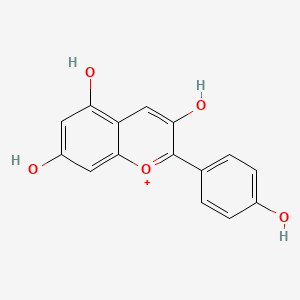| MeSH term | MeSH ID | Detail |
|---|---|---|
| Cystitis | D003556 | 23 associated lipids |
| Parkinsonian Disorders | D020734 | 20 associated lipids |
Pelargonidin
Pelargonidin is a lipid of Polyketides (PK) class. The involved functions are known as Uptake, Intestinal Absorption, glucose uptake, Process and Metabolic Inhibition. Pelargonidin often locates in Serosal, Mucous Membrane, brush border membrane, Membrane and Cell surface. The associated genes with Pelargonidin are SLC5A1 gene, SLC2A2 gene, Homologous Gene, F3 gene and CRSP3 gene. The related experimental models are Knock-out.
Cross Reference
Introduction
To understand associated biological information of Pelargonidin, we collected biological information of abnormalities, associated pathways, cellular/molecular locations, biological functions, related genes/proteins, lipids and common seen animal/experimental models with organized paragraphs from literatures.
What diseases are associated with Pelargonidin?
There are no associated biomedical information in the current reference collection.
Possible diseases from mapped MeSH terms on references
We collected disease MeSH terms mapped to the references associated with Pelargonidin
PubChem Associated disorders and diseases
What pathways are associated with Pelargonidin
There are no associated biomedical information in the current reference collection.
PubChem Biomolecular Interactions and Pathways
Link to PubChem Biomolecular Interactions and PathwaysWhat cellular locations are associated with Pelargonidin?
Visualization in cellular structure
Associated locations are in red color. Not associated locations are in black.
Related references are published most in these journals:
| Location | Cross reference | Weighted score | Related literatures |
|---|
What functions are associated with Pelargonidin?
Related references are published most in these journals:
| Function | Cross reference | Weighted score | Related literatures |
|---|
What lipids are associated with Pelargonidin?
There are no associated biomedical information in the current reference collection.
What genes are associated with Pelargonidin?
Related references are published most in these journals:
| Gene | Cross reference | Weighted score | Related literatures |
|---|
What common seen animal models are associated with Pelargonidin?
Knock-out
Knock-out are used in the study 'MATE2 mediates vacuolar sequestration of flavonoid glycosides and glycoside malonates in Medicago truncatula.' (Zhao J et al., 2011).
Related references are published most in these journals:
| Model | Cross reference | Weighted score | Related literatures |
|---|
NCBI Entrez Crosslinks
All references with Pelargonidin
Download all related citations| Authors | Title | Published | Journal | PubMed Link |
|---|---|---|---|---|
| Cvorovic J et al. | Oxidative stress-based cytotoxicity of delphinidin and cyanidin in colon cancer cells. | 2010 | Arch. Biochem. Biophys. | pmid:20494645 |
| Lee IC and Bae JS | Suppressive effects of pelargonidin on PolyPhosphate-mediated vascular inflammatory responses. | 2017 | Arch. Pharm. Res. | pmid:27826751 |
| Min G et al. | Anti-septic effects of pelargonidin on HMGB1-induced responses in vitro and in vivo. | 2016 | Arch. Pharm. Res. | pmid:27778275 |
| Ku SK et al. | Antithrombotic and antiplatelet activities of pelargonidin in vivo and in vitro. | 2016 | Arch. Pharm. Res. | pmid:26762345 |
| Abe Y et al. | Detection of 1-O-malylglucose: pelargonidin 3-O-glucose-6''-O-malyltransferase activity in carnation (Dianthus caryophyllus). | 2008 | Biochem. Biophys. Res. Commun. | pmid:18471436 |
| Dreiseitel A et al. | Inhibition of proteasome activity by anthocyanins and anthocyanidins. | 2008 | Biochem. Biophys. Res. Commun. | pmid:18460339 |
| Son JE et al. | Pelargonidin attenuates PDGF-BB-induced aortic smooth muscle cell proliferation and migration by direct inhibition of focal adhesion kinase. | 2014 | Biochem. Pharmacol. | pmid:24582770 |
| Hou DX et al. | Anthocyanidins inhibit cyclooxygenase-2 expression in LPS-evoked macrophages: structure-activity relationship and molecular mechanisms involved. | 2005 | Biochem. Pharmacol. | pmid:15963474 |
| Grigoriev SM et al. | Regulation of mitochondrial KATP channel by redox agents. | 1999 | Biochim. Biophys. Acta | pmid:10076019 |
| Ganugapati J et al. | Molecular docking studies of banana flower flavonoids as insulin receptor tyrosine kinase activators as a cure for diabetes mellitus. | 2012 | Bioinformation | pmid:22493522 |
